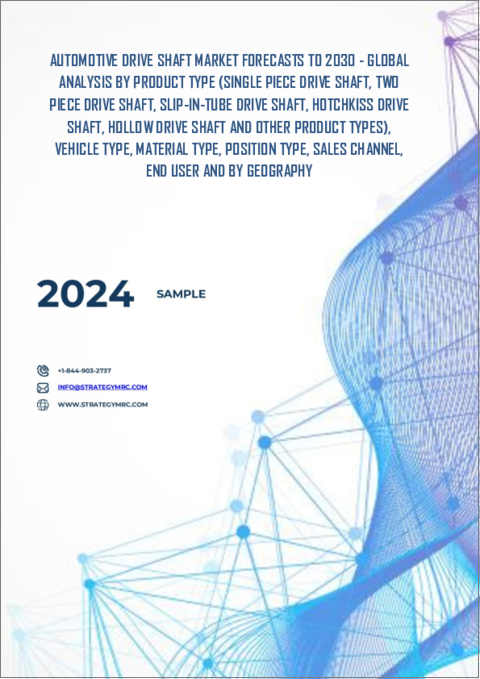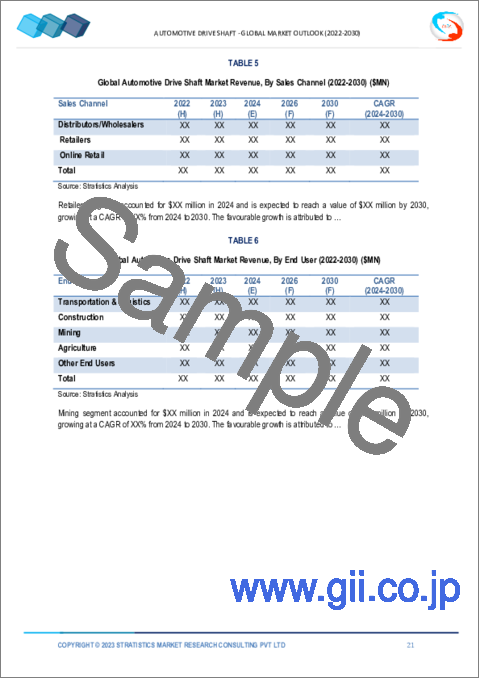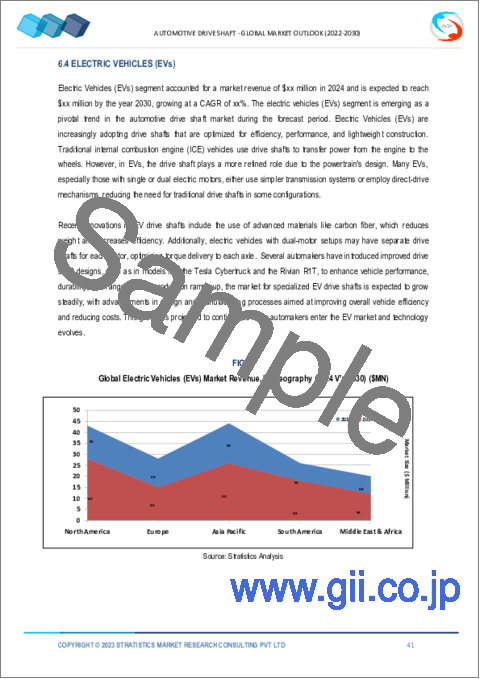|
|
市場調査レポート
商品コード
1503412
自動車用ドライブシャフト市場の2030年までの予測: 製品タイプ別、車種別、材料タイプ別、ポジションタイプ別、販売チャネル別、エンドユーザー別、地域別の世界分析Automotive Drive Shaft Market Forecasts to 2030 - Global Analysis By Product Type, Vehicle Type, Material Type, Position Type, Sales Channel, End User and By Geography |
||||||
カスタマイズ可能
|
|||||||
| 自動車用ドライブシャフト市場の2030年までの予測: 製品タイプ別、車種別、材料タイプ別、ポジションタイプ別、販売チャネル別、エンドユーザー別、地域別の世界分析 |
|
出版日: 2024年06月06日
発行: Stratistics Market Research Consulting
ページ情報: 英文 200+ Pages
納期: 2~3営業日
|
全表示
- 概要
- 図表
- 目次
Stratistics MRCによると、自動車用ドライブシャフトの世界市場は2024年に742億米ドルを占め、予測期間中のCAGRは8.5%で成長し、2030年には1,210億米ドルに達すると予測されています。
自動車用ドライブシャフトは、プロペラシャフトとしても知られ、エンジンとトランスミッションから車両の車輪にトルクと回転を伝達するために使用される機械部品です。後輪駆動車、四輪駆動車、全輪駆動車において、トランスミッションをディファレンシャルに接続し、ディファレンシャルが動力を車輪に伝達するという重要な役割を果たします。通常、スチール製またはアルミニウム製のドライブシャフトは、高速回転とさまざまな荷重のストレスに対応するため、強度とバランスが求められます。
中国汽車工業協会(CAAM)によると、2022年7月の中国の自動車販売台数は前年比29.7%増の242万台と急増し、純電気自動車、プラグインハイブリッド車、水素燃料電池車を含む新エネルギー車の販売台数は前年比120%増となった。
電気自動車(EV)の需要増加
電気自動車(EV)の需要増は市場に大きな影響を与えています。EVの普及に伴い、メーカーは効率と性能を高めるために先進的な軽量ドライブシャフトを開発しています。この急増の背景には、環境問題、政府の規制、持続可能な輸送に対する消費者の嗜好があります。その結果、市場はEV用途に合わせた革新的な材料と設計へのシフトを経験しており、電気ドライブトレインとの互換性を確保し、車両全体の効率と排出量削減に貢献しています。
自動車サプライチェーンの混乱
市場は、サプライチェーンの混乱による大きな課題に直面しています。世界の半導体不足、物流の遅れ、原材料価格の変動などの要因によって引き起こされるこうした混乱は、ドライブシャフトのタイムリーな生産と納入を妨げます。さらに、地政学的な緊張や貿易制限がこうした問題を悪化させ、コスト増と生産の遅れにつながっています。メーカーは、こうした混乱を緩和し、市場の安定性を維持するために、代替調達戦略を模索し、サプライチェーンの回復力を高める必要に迫られています。
厳しい排出ガス規制
市場における厳しい排出ガス規制が大きな変化を促しています。世界各国の政府は、自動車の排出ガスを削減するためにより厳しい基準を設けており、メーカーは先進的な材料と技術を採用せざるを得なくなっています。このシフトは、燃料効率を高め、環境への影響を最小限に抑えることを目的としています。カーボンファイバーやアルミニウムなど、軽量で高強度な素材への注目の高まりは、コンプライアンスにとって極めて重要です。その結果、ドライブシャフト・メーカーはこれらの規制を満たすために技術革新を進め、持続可能性を促進し、自動車業界の二酸化炭素排出量を削減しています。
変動する原材料価格
市場は、原材料価格、特に鉄鋼とアルミニウムの価格変動による課題に直面しています。こうした価格変動は製造コストと利益率に影響を及ぼし、製品価格の不安定化を招く可能性があります。メーカーは、こうした影響を緩和するために、サプライ・チェーンを最適化し、長期契約を交渉することで適応しなければならないです。さらに、技術の進歩や代替材料が解決策を提供する可能性もあるが、競争力を維持し、安定した生産コストを確保するためには、市場動向の一貫した監視が不可欠であることに変わりはないです。
COVID-19の影響:
COVID-19の大流行は自動車用ドライブシャフト市場を大きく混乱させ、製造の停止と自動車販売の減少による需要の急減を引き起こしました。サプライチェーンの混乱により原材料や部品が不足し、生産がさらに妨げられました。しかし、規制が緩和されるにつれて、自動車生産が再開され、自家用車の需要が増加したため、市場は回復し始めました。電気自動車へのシフトも、先進的なドライブシャフト技術に新たな成長機会をもたらしました。
予測期間中はアルミニウム・セグメントが最大になる見込み
予測期間中はアルミニウムが最大となる見込みです。軽量でありながら耐久性に優れた特性を持つアルミニウムは、ドライブシャフト製造において従来のスチールよりもますます支持されるようになっています。この変化は主に、燃費効率と性能の向上を追求する自動車業界によってもたらされています。アルミニウムの優れた強度対重量比は、車両重量を減らすだけでなく、排出ガスの低減やハンドリングダイナミクスの向上にも貢献します。
予測期間中にCAGRが最も高くなると予想されるのは建設分野です。
予測期間中、CAGRが最も高くなると予想されるのは建設分野です。メーカーは、車両性能と燃費を向上させるため、軽量でありながら耐久性のあるドライブシャフトの開発に注力しています。さらに、電気自動車やハイブリッド車の生産台数の増加が市場拡大をさらに後押しし、革新的なドライブシャフトソリューションの研究開発への投資を促しています。自動車用ドライブシャフト分野のこのような建設ブームは、進化する消費者の嗜好と規制基準に対する業界のダイナミックな対応を反映しています。
最大のシェアを占める地域
北米は、好調な自動車産業、技術の進歩、低燃費車の需要増加などの要因によって、予測期間中最大の市場シェアを占めると予測されます。技術革新と持続可能性に焦点を当て、主要企業は軽量で耐久性のあるドライブシャフトを導入するための研究開発に投資しています。また、厳しい排ガス規制は、メーカーが最適な車両性能を確保しながらコンプライアンス基準を満たすよう努めているため、市場の成長をさらに後押ししています。
CAGRが最も高い地域:
予測期間中、アジア太平洋地域が最も高いCAGRを維持すると予測されます。この地域は急速な都市化が進んでおり、乗用車や商用車を含む自動車需要の増加につながっています。このような自動車販売の急増は、ドライブシャフトの需要に直接影響を与えます。燃費と排ガスに関する厳しい規制により、自動車メーカーは性能を向上させ規制基準を満たすために、ドライブシャフトを含む自動車部品に軽量材料と先進技術を採用するようになっています。
無料のカスタマイズサービス:
本レポートをご購読のお客様には、以下の無料カスタマイズオプションのいずれかをご利用いただけます:
- 企業プロファイル
- 追加市場プレイヤーの包括的プロファイリング(3社まで)
- 主要企業のSWOT分析(3社まで)
- 地域セグメンテーション
- 顧客の関心に応じた主要国の市場推計・予測・CAGR(注:フィージビリティチェックによる)
- 競合ベンチマーキング
- 製品ポートフォリオ、地理的プレゼンス、戦略的提携に基づく主要企業のベンチマーキング
目次
第1章 エグゼクティブサマリー
第2章 序文
- 概要
- ステークホルダー
- 調査範囲
- 調査手法
- データマイニング
- データ分析
- データ検証
- 調査アプローチ
- 調査情報源
- 1次調査情報源
- 2次調査情報源
- 前提条件
第3章 市場動向分析
- 促進要因
- 抑制要因
- 機会
- 脅威
- 製品分析
- エンドユーザー分析
- 新興市場
- COVID-19の影響
第4章 ポーターのファイブフォース分析
- 供給企業の交渉力
- 買い手の交渉力
- 代替品の脅威
- 新規参入業者の脅威
- 競争企業間の敵対関係
第5章 世界の自動車用ドライブシャフト市場:製品タイプ別
- シングルピースドライブシャフト
- 2ピースドライブシャフト
- スリップインチューブドライブシャフト
- ホッチキスドライブシャフト
- 中空ドライブシャフト
- その他の製品タイプ
第6章 世界の自動車用ドライブシャフト市場:車種別
- 乗用車
- 商用車
- 電気自動車(EV)
第7章 世界の自動車用ドライブシャフト市場:材料タイプ別
- 鋼鉄
- アルミニウム
- カーボンファイバー
- 複合
第8章 世界の自動車用ドライブシャフト市場:ポジションタイプ別
- 前輪駆動(FWD)車
- 後輪駆動(RWD)車両
- 全輪駆動(AWD)車
第9章 世界の自動車用ドライブシャフト市場:販売チャネル別
- 販売業者/卸売業者
- 小売業者
- オンライン小売
第10章 世界の自動車用ドライブシャフト市場:エンドユーザー別
- 運輸・物流
- 建設
- 鉱業
- 農業
- その他のエンドユーザー
第11章 世界の自動車用ドライブシャフト市場:地域別
- 北米
- 米国
- カナダ
- メキシコ
- 欧州
- ドイツ
- 英国
- イタリア
- フランス
- スペイン
- その他欧州
- アジア太平洋地域
- 日本
- 中国
- インド
- オーストラリア
- ニュージーランド
- 韓国
- その他アジア太平洋地域
- 南米
- アルゼンチン
- ブラジル
- チリ
- その他南米
- 中東・アフリカ
- サウジアラビア
- アラブ首長国連邦
- カタール
- 南アフリカ
- その他中東とアフリカ
第12章 主な発展
- 契約、パートナーシップ、コラボレーション、合弁事業
- 買収と合併
- 新製品発売
- 事業拡大
- その他の主要戦略
第13章 企業プロファイリング
- Dana Incorporated
- Hyundai Wia Corporation
- Nexteer Automotive
- Meritor, Inc.
- Yamada Manufacturing Co., Ltd.
- GSP Automotive Group Wenzhou Co., Ltd.
- Dorman Products, Inc.
- Heri Automotive, Inc.
- Dynamax Industries
- Showa Corporation
- American Axle & Manufacturing Co. Ltd
- Wanxiang Qianchao Co. Ltd
- JTEKT Corporation
List of Tables
- Table 1 Global Automotive Drive Shaft Market Outlook, By Region (2022-2030) ($MN)
- Table 2 Global Automotive Drive Shaft Market Outlook, By Product Type (2022-2030) ($MN)
- Table 3 Global Automotive Drive Shaft Market Outlook, By Single Piece Drive Shaft (2022-2030) ($MN)
- Table 4 Global Automotive Drive Shaft Market Outlook, By Two Piece Drive Shaft (2022-2030) ($MN)
- Table 5 Global Automotive Drive Shaft Market Outlook, By Slip-in-Tube Drive Shaft (2022-2030) ($MN)
- Table 6 Global Automotive Drive Shaft Market Outlook, By Hotchkiss Drive Shaft (2022-2030) ($MN)
- Table 7 Global Automotive Drive Shaft Market Outlook, By Hollow Drive Shaft (2022-2030) ($MN)
- Table 8 Global Automotive Drive Shaft Market Outlook, By Other Product Types (2022-2030) ($MN)
- Table 9 Global Automotive Drive Shaft Market Outlook, By Vehicle Type (2022-2030) ($MN)
- Table 10 Global Automotive Drive Shaft Market Outlook, By Passenger Cars (2022-2030) ($MN)
- Table 11 Global Automotive Drive Shaft Market Outlook, By Commercial Vehicles (2022-2030) ($MN)
- Table 12 Global Automotive Drive Shaft Market Outlook, By Electric Vehicles (EVs) (2022-2030) ($MN)
- Table 13 Global Automotive Drive Shaft Market Outlook, By Material Type (2022-2030) ($MN)
- Table 14 Global Automotive Drive Shaft Market Outlook, By Steel (2022-2030) ($MN)
- Table 15 Global Automotive Drive Shaft Market Outlook, By Aluminum (2022-2030) ($MN)
- Table 16 Global Automotive Drive Shaft Market Outlook, By Carbon Fiber (2022-2030) ($MN)
- Table 17 Global Automotive Drive Shaft Market Outlook, By Composite (2022-2030) ($MN)
- Table 18 Global Automotive Drive Shaft Market Outlook, By Position Type (2022-2030) ($MN)
- Table 19 Global Automotive Drive Shaft Market Outlook, By Front Wheel Drive (FWD) Vehicles (2022-2030) ($MN)
- Table 20 Global Automotive Drive Shaft Market Outlook, By Rear Wheel Drive (RWD) Vehicles (2022-2030) ($MN)
- Table 21 Global Automotive Drive Shaft Market Outlook, By All-Wheel Drive (AWD) Vehicles (2022-2030) ($MN)
- Table 22 Global Automotive Drive Shaft Market Outlook, By Sales Channel (2022-2030) ($MN)
- Table 23 Global Automotive Drive Shaft Market Outlook, By Distributors/Wholesalers (2022-2030) ($MN)
- Table 24 Global Automotive Drive Shaft Market Outlook, By Retailers (2022-2030) ($MN)
- Table 25 Global Automotive Drive Shaft Market Outlook, By Online Retail (2022-2030) ($MN)
- Table 26 Global Automotive Drive Shaft Market Outlook, By End User (2022-2030) ($MN)
- Table 27 Global Automotive Drive Shaft Market Outlook, By Transportation & Logistics (2022-2030) ($MN)
- Table 28 Global Automotive Drive Shaft Market Outlook, By Construction (2022-2030) ($MN)
- Table 29 Global Automotive Drive Shaft Market Outlook, By Mining (2022-2030) ($MN)
- Table 30 Global Automotive Drive Shaft Market Outlook, By Agriculture (2022-2030) ($MN)
- Table 31 Global Automotive Drive Shaft Market Outlook, By Other End Users (2022-2030) ($MN)
Note: Tables for North America, Europe, APAC, South America, and Middle East & Africa Regions are also represented in the same manner as above.
According to Stratistics MRC, the Global Automotive Drive Shaft Market is accounted for $74.2 billion in 2024 and is expected to reach $121.0 billion by 2030 growing at a CAGR of 8.5% during the forecast period. An automotive drive shaft, also known as a propeller shaft, is a mechanical component used to transmit torque and rotation from the engine and transmission to the vehicle's wheels. It plays a crucial role in rear-wheel drive, four-wheel drive, and all-wheel drive vehicles by connecting the transmission to the differential, which then transfers power to the wheels. Typically made of steel or aluminum, the drive shaft must be strong and balanced to handle the stresses of high-speed rotation and varying loads.
According to the China Association of Automobile Manufacturers (CAAM), China's auto sales surged 29.7% in July 2022, standing at 2.42 million units, compared to the previous year, and Sales of new energy vehicles, which include pure electric vehicles, plug-in hybrids, and hydrogen fuel-cell vehicles, increased 120% in July 2022 from the previous year.
Market Dynamics:
Driver:
Increasing demand for electric vehicles (EVs)
The increasing demand for electric vehicles (EVs) is significantly impacting the market. As EV adoption grows, manufacturers are developing advanced, lightweight drive shafts to enhance efficiency and performance. This surge is driven by environmental concerns, government regulations, and consumer preference for sustainable transportation. Consequently, the market is experiencing a shift towards innovative materials and designs tailored for EV applications, ensuring compatibility with electric drivetrains and contributing to overall vehicle efficiency and reduced emissions.
Restraint:
Disruptions in the automotive supply chain
The market faces significant challenges due to disruptions in the supply chain. These disruptions, caused by factors such as global semiconductor shortages, logistical delays, and fluctuating raw material prices, hinder the timely production and delivery of drive shafts. Additionally, geopolitical tensions and trade restrictions exacerbate these issues, leading to increased costs and production delays. Manufacturers are compelled to seek alternative sourcing strategies and enhance supply chain resilience to mitigate these disruptions and maintain market stability.
Opportunity:
Stringent emission regulations
Stringent emission regulations in the market are driving significant changes. Governments worldwide are enforcing stricter standards to reduce vehicle emissions, compelling manufacturers to adopt advanced materials and technologies. This shift aims to enhance fuel efficiency and minimize environmental impact. The increased focus on lightweight, high-strength materials, such as carbon fiber and aluminum, is crucial for compliance. As a result, drive shaft manufacturers are innovating to meet these regulations, promoting sustainability and reducing the automotive industry's carbon footprint.
Threat:
Fluctuating raw material prices
The market faces challenges due to fluctuating raw material prices, particularly steel and aluminum. These price variations impact manufacturing costs and profit margins, leading to potential instability in product pricing. Manufacturers must adapt by optimizing supply chains and negotiating long-term contracts to mitigate these effects. Additionally, technological advancements and alternative materials may offer solutions, but consistent monitoring of market trends remains essential for maintaining competitiveness and ensuring stable production costs.
Covid-19 Impact:
The COVID-19 pandemic significantly disrupted the automotive drive shaft market, causing a steep decline in demand due to halted manufacturing and reduced vehicle sales. Supply chain disruptions led to shortages of raw materials and components, further hindering production. However, as restrictions eased, the market began to recover, driven by renewed automotive production and increased demand for personal vehicles. The shift towards electric vehicles also presented new growth opportunities for advanced drive shaft technologies.
The aluminum segment is expected to be the largest during the forecast period
The aluminum is expected to be the largest during the forecast period. With its lightweight yet durable properties, aluminum is increasingly favored over traditional steel in drive shaft manufacturing. This shift is primarily driven by the automotive industry's quest for enhanced fuel efficiency and performance. Aluminum's excellent strength-to-weight ratio not only reduces vehicle weight but also contributes to lower emissions and improved handling dynamics.
The construction segment is expected to have the highest CAGR during the forecast period
The construction segment is expected to have the highest CAGR during the forecast period. Manufacturers are focusing on developing lightweight yet durable drive shafts to enhance vehicle performance and fuel economy. Additionally, the growing production of electric and hybrid vehicles is further propelling market expansion, prompting investments in research and development for innovative drive shaft solutions. This construction boom in the automotive drive shaft sector reflects the industry's dynamic response to evolving consumer preferences and regulatory standards.
Region with largest share:
North America is projected to hold the largest market share during the forecast period driven by factors such as the region's strong automotive industry, technological advancements, and increasing demand for fuel-efficient vehicles. With a focus on innovation and sustainability, key players are investing in research and development to introduce lightweight and durable drive shafts. Additionally, stringent emission regulations are further propelling market growth as manufacturers strive to meet compliance standards while ensuring optimal vehicle performance.
Region with highest CAGR:
Asia Pacific is projected to hold the highest CAGR over the forecast period. The region is experiencing rapid urbanization, leading to increased demand for automobiles, including passenger cars and commercial vehicles. This surge in automotive sales directly impacts the demand for drive shafts. Stringent regulations related to fuel efficiency and emissions have prompted automakers to adopt lightweight materials and advanced technologies in vehicle components, including drive shafts, to enhance performance and meet regulatory standards.
Key players in the market
Some of the key players in Automotive Drive Shaft Market include Dana Incorporated, Hyundai Wia Corporation, Nexteer Automotive, Meritor, Inc., Yamada Manufacturing Co., Ltd., GSP Automotive Group Wenzhou Co., Ltd., Dorman Products, Inc., Heri Automotive, Inc., Dynamax Industries, Showa Corporation, American Axle & Manufacturing Co. Ltd, Wanxiang Qianchao Co. Ltd and JTEKT Corporation.
Key Developments:
In January 2023, Dana Cardenas opened a new USD 21 million plant in Queretaro, Mexico, with a production line that will make Toyota components. The first production line, which already began with 110 employees, will be joined by two more lines later in 2023 for a total annual production of 545,000 units with 300 employees.
In December 2022, JTEKT Corporation (JTEKT) announced the adoption of their "low-vibration drive shaft" for Toyota Motor Corporation's Lexus RX front-wheel drive. The low-vibration drive shaft uses an "opposite groove construction," in which 6 balls are incorporated in the ball joint on the tire side, and the pushing loads of the opposing three balls cancel each other out, reducing internal friction by half.
Product Types Covered:
- Single Piece Drive Shaft
- Two Piece Drive Shaft
- Slip-in-Tube Drive Shaft
- Hotchkiss Drive Shaft
- Hollow Drive Shaft
- Other Product Types
Vehicle Types Covered:
- Passenger Cars
- Commercial Vehicles
- Electric Vehicles (EVs)
Material Types Covered:
- Steel
- Aluminum
- Carbon Fiber
- Composite
Applications Covered:
- Front Wheel Drive (FWD) Vehicles
- Rear Wheel Drive (RWD) Vehicles
- All-Wheel Drive (AWD) Vehicles
Sales Channels Covered:
- Distributors/Wholesalers
- Retailers
- Online Retail
End Users Covered:
- Transportation & Logistics
- Construction
- Mining
- Agriculture
- Other End Users
Regions Covered:
- North America
- US
- Canada
- Mexico
- Europe
- Germany
- UK
- Italy
- France
- Spain
- Rest of Europe
- Asia Pacific
- Japan
- China
- India
- Australia
- New Zealand
- South Korea
- Rest of Asia Pacific
- South America
- Argentina
- Brazil
- Chile
- Rest of South America
- Middle East & Africa
- Saudi Arabia
- UAE
- Qatar
- South Africa
- Rest of Middle East & Africa
What our report offers:
- Market share assessments for the regional and country-level segments
- Strategic recommendations for the new entrants
- Covers Market data for the years 2022, 2023, 2024, 2026, and 2030
- Market Trends (Drivers, Constraints, Opportunities, Threats, Challenges, Investment Opportunities, and recommendations)
- Strategic recommendations in key business segments based on the market estimations
- Competitive landscaping mapping the key common trends
- Company profiling with detailed strategies, financials, and recent developments
- Supply chain trends mapping the latest technological advancements
Free Customization Offerings:
All the customers of this report will be entitled to receive one of the following free customization options:
- Company Profiling
- Comprehensive profiling of additional market players (up to 3)
- SWOT Analysis of key players (up to 3)
- Regional Segmentation
- Market estimations, Forecasts and CAGR of any prominent country as per the client's interest (Note: Depends on feasibility check)
- Competitive Benchmarking
- Benchmarking of key players based on product portfolio, geographical presence, and strategic alliances
Table of Contents
1 Executive Summary
2 Preface
- 2.1 Abstract
- 2.2 Stake Holders
- 2.3 Research Scope
- 2.4 Research Methodology
- 2.4.1 Data Mining
- 2.4.2 Data Analysis
- 2.4.3 Data Validation
- 2.4.4 Research Approach
- 2.5 Research Sources
- 2.5.1 Primary Research Sources
- 2.5.2 Secondary Research Sources
- 2.5.3 Assumptions
3 Market Trend Analysis
- 3.1 Introduction
- 3.2 Drivers
- 3.3 Restraints
- 3.4 Opportunities
- 3.5 Threats
- 3.6 Product Analysis
- 3.7 End User Analysis
- 3.8 Emerging Markets
- 3.9 Impact of Covid-19
4 Porters Five Force Analysis
- 4.1 Bargaining power of suppliers
- 4.2 Bargaining power of buyers
- 4.3 Threat of substitutes
- 4.4 Threat of new entrants
- 4.5 Competitive rivalry
5 Global Automotive Drive Shaft Market, By Product Type
- 5.1 Introduction
- 5.2 Single Piece Drive Shaft
- 5.3 Two Piece Drive Shaft
- 5.4 Slip-in-Tube Drive Shaft
- 5.5 Hotchkiss Drive Shaft
- 5.6 Hollow Drive Shaft
- 5.7 Other Product Types
6 Global Automotive Drive Shaft Market, By Vehicle Type
- 6.1 Introduction
- 6.2 Passenger Cars
- 6.3 Commercial Vehicles
- 6.4 Electric Vehicles (EVs)
7 Global Automotive Drive Shaft Market, By Material Type
- 7.1 Introduction
- 7.2 Steel
- 7.3 Aluminum
- 7.4 Carbon Fiber
- 7.5 Composite
8 Global Automotive Drive Shaft Market, By Position Type
- 8.1 Introduction
- 8.2 Front Wheel Drive (FWD) Vehicles
- 8.3 Rear Wheel Drive (RWD) Vehicles
- 8.4 All-Wheel Drive (AWD) Vehicles
9 Global Automotive Drive Shaft Market, By Sales Channel
- 9.1 Introduction
- 9.2 Distributors/Wholesalers
- 9.3 Retailers
- 9.4 Online Retail
10 Global Automotive Drive Shaft Market, By End User
- 10.1 Introduction
- 10.2 Transportation & Logistics
- 10.3 Construction
- 10.4 Mining
- 10.5 Agriculture
- 10.6 Other End Users
11 Global Automotive Drive Shaft Market, By Geography
- 11.1 Introduction
- 11.2 North America
- 11.2.1 US
- 11.2.2 Canada
- 11.2.3 Mexico
- 11.3 Europe
- 11.3.1 Germany
- 11.3.2 UK
- 11.3.3 Italy
- 11.3.4 France
- 11.3.5 Spain
- 11.3.6 Rest of Europe
- 11.4 Asia Pacific
- 11.4.1 Japan
- 11.4.2 China
- 11.4.3 India
- 11.4.4 Australia
- 11.4.5 New Zealand
- 11.4.6 South Korea
- 11.4.7 Rest of Asia Pacific
- 11.5 South America
- 11.5.1 Argentina
- 11.5.2 Brazil
- 11.5.3 Chile
- 11.5.4 Rest of South America
- 11.6 Middle East & Africa
- 11.6.1 Saudi Arabia
- 11.6.2 UAE
- 11.6.3 Qatar
- 11.6.4 South Africa
- 11.6.5 Rest of Middle East & Africa
12 Key Developments
- 12.1 Agreements, Partnerships, Collaborations and Joint Ventures
- 12.2 Acquisitions & Mergers
- 12.3 New Product Launch
- 12.4 Expansions
- 12.5 Other Key Strategies
13 Company Profiling
- 13.1 Dana Incorporated
- 13.2 Hyundai Wia Corporation
- 13.3 Nexteer Automotive
- 13.4 Meritor, Inc.
- 13.5 Yamada Manufacturing Co., Ltd.
- 13.6 GSP Automotive Group Wenzhou Co., Ltd.
- 13.7 Dorman Products, Inc.
- 13.8 Heri Automotive, Inc.
- 13.9 Dynamax Industries
- 13.10 Showa Corporation
- 13.11 American Axle & Manufacturing Co. Ltd
- 13.12 Wanxiang Qianchao Co. Ltd
- 13.13 JTEKT Corporation






